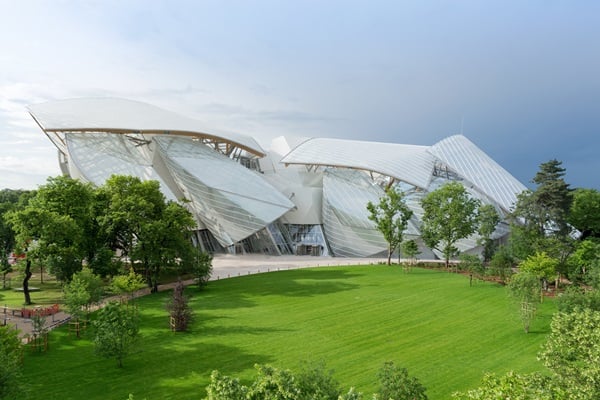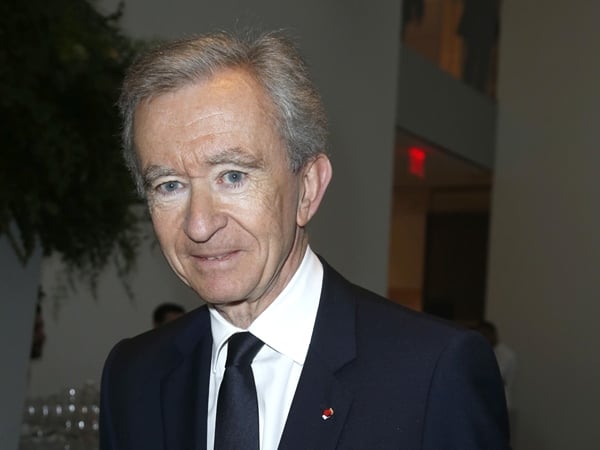People
Bernard Arnault Opens Up About Art, Fashion, and His New Museum
The Fondation Louis Vuitton is the crown jewel of his luxury goods empire.

The Fondation Louis Vuitton is the crown jewel of his luxury goods empire.

Eileen Kinsella

On the eve of the opening of the new Fondation Louis Vuitton in Paris’s Bois de Boulogne park, the Financial Times‘s weekend “How to Spend It” section is led by a fascinating in-depth profile of LVMH CEO and renowned art collector Bernard Arnault. The piece, penned by Nick Foulkes, breaks down everything, from the roots and the rise of his luxury goods empire to his love of art and history of collecting, as well as how the visionary leader views the integration of art and fashion his company has executed so successfully over the years.
By turn fawning and insightful, Foulkes describes Arnault as “utterly charming” as they share a breakfast of “coffee, fruit, croissants, and crusty French bread.” He describes Arnault as “quietly spoken, tall, pale, and elegant…this is what a fortune of $33bn (give or take) looks like in human form.” What makes Arnault so intriguing as a collector, Foulkes opines, is the way that “he has blurred, if not erased, the line between art and commerce. Warhol would have loved what he has done with Louis Vuitton.”
According to the profile, Arnault values creativity most, in an attitude that borders on religious. And the numerous collaborations over the years with such artists as Takashi Murakami, the late Stephen Sprouse, Richard Prince, Yayoi Kusama, and Olafur Eliasson have “changed the relationship between luxury, fashion, and art.” In addition, some stores have art bookshops with selections curated by top artists, and there are dedicated galleries, or “espaces culturels” in other spaces. The Vuitton shoe factory in the Veneto region of Italy, apparently, has a large work by top-selling Portuguese artist Joana Vasconcelos as well as some early Warhols. According to the article, “it is fascinating to see how [Arnault] seems to relax when he talks about paintings and music, with discussion ranging from Chopin to Schubert, to Koons to Sterling Ruby.”

Arnault tells Foulkes about his first auction purchase, a Claude Monet early 20th-century depiction of Charing Cross Bridge. Arnault recounts his initial reaction upon seeing the work—”No it’s not possible, there is a Monet for sale”—and his pleasant surprise at being the winning bidder: “I was the only one to bid for it, and I got it for a relatively low amount.” He finds joy in being the first to discover things, as was the case with a “rainbow bright” Mark Rothko that he bought at a time “when everyone wanted dark, dramatic works dating from shortly before the artist’s suicide.” (Arnault also believes French artist Bernard Buffet may be underrated, and yes, he owns at least one of his works.)
While Arnault says he only buys artworks for his personal collection that he likes and “can live with for a long time,” buying for the Fondation Louis Vuitton is different: Not only does he have to like it, but foundation curator Suzanne Page has to consider it something worth showing. “‘I mean, I don’t think she would like to have my Monet,’ the chairman quips. The foundation focuses on the connection between contemporary artists and the second part of the last century. ‘So you see the evolution,'”he tells the FT.

Bernard Arnault.
Photo: © 2014 Patrick McMullan Company, Inc.
Another major portion of the article is devoted to international starchitect Frank Gehry, designer of the Fondation building. Gehry shows up for a photo shoot with Arnault in front of the new building and weighs in on the dazzling design he came up with for it. The piece includes shots of the two men standing proudly in front of the new, awe-inspiring structure, but no actual shots of the building interior.
Though Gehry’s personal style is described as “laid-back West Coast USA,” when he starts to talk, he is “impossible to ignore, as he weaves a sparkling and uninhibited conversational tapestry.” Gehry describes the Fondation Louis Vuitton building as a mixture of three elements already commonly used by viewers to describe it—a ship, a cloud, and an iceberg dressed as a cloud. “The iceberg is the white stuff inside, the cloud is the glass, and the glass looks like sails,” says Gehry. It is interesting to note that similar words, by Gehry himself and other observers, have been applied to Gehry’s IAC building to house corporate titan Barry Diller’s media empire in West Chelsea. (Such hifalutin language was not enough to save Gehry from losing a major commission at Ground Zero—see “Frank Gehry Fired from World Trade Center Arts Complex Job.”)
The new Vuitton building, slated to open October 27, is described as “a multi-gallery museum, auditorium, and cultural space.” Foulkes says he has “never knowingly gasped in awe and wonder,” but came close to doing so when he laid eyes on the structure for the first time. He describes it as “a soaring structure of huge swirling panes of glass [that] seems to hang like mist amid the trees.”
Then Foulkes gets a little carried away, breathlessly imagining that this may have been what it was like for earlier viewers of “a sand dune in Giza around two and a half millenia before the birth of Christ as they were putting the finishing touches to the pyramid of Cheops; to have seen the Colosseum rise above ancient Rome; or… to have witnessed Monsieur Eiffel’s eponymous experiment in ironmongery climbing rivet by rivet towards the sky.”